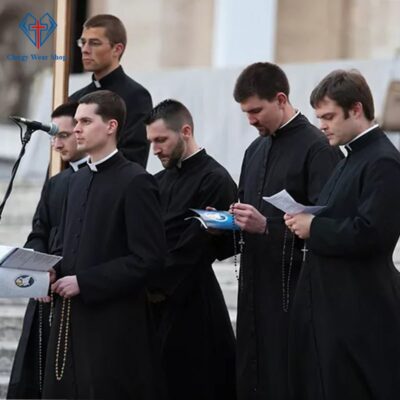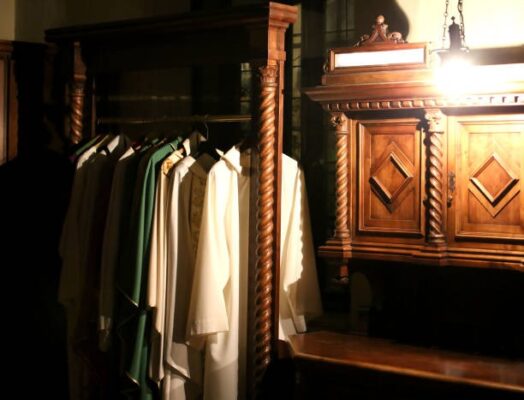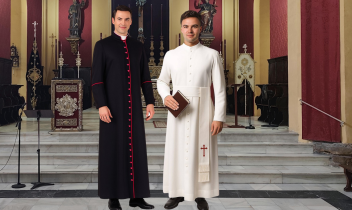No products in the cart.
Return To Shop
Looking for Clergy Attire | Clergy Attire Store near Me
Understanding the Significance of Clergy Attire
Clergy attire holds deep significance in many religious traditions. It serves as a visual representation of one’s role and commitment to faith. The attire often includes distinctive elements that set clergy members apart from the congregation and signify their authority and dedication to their religious duties.
Common Elements of Clergy Attire

- Cassock: The cassock, often referred to as a “robe,” is a long, ankle-length garment worn by clergy members in many Christian denominations. Its design is simple and unadorned, typically black, though variations in color may be seen among different traditions. The cassock serves as a symbol of humility and devotion, and its significance extends beyond its appearance. Order online.
- Surplice: Suplice is a white, knee-length garment that is typically worn over the cassock during religious ceremonies and services. It is characterized by its loose and flowing design, often with wide sleeves. The surplice is associated with the clergy’s role in leading worship and administering sacraments. Order online.
- Clerical Collar: One of the most recognizable elements, the clerical collar, is typically worn by clergy members such as priests and ministers. It consists of a white band or collar that encircles the neck and is usually worn with a black shirt or robe. Order online.
- Robes and Vestments: Different religious denominations have varying styles and colors of robes and vestments. These garments are often worn during religious services and can include cassocks, chasubles, albs, and stoles.
- Mitres and Hats: In some traditions, clergy members wear distinctive headwear, such as mitres (pointed hats) for bishops or zucchettos (skullcaps) for priests.
- Cinctures and Sashes: These are belts or sashes worn around the waist to secure robes and vestments. They can vary in color and design, often symbolizing different aspects of faith.
- Shoes: While not always as prominent, the type of shoes worn by clergy can also be significant. Some wear traditional styles, while others opt for more practical footwear.
Where to Find Clergy Attire | Clergy Wear Shop
When searching for clergy attire, there are several options to consider:
- Religious Supply Stores: Many cities have specialized religious supply stores that offer a wide range of clergy attire and accessories. These stores often cater to various denominations and can provide guidance on appropriate attire.
- Online Retailers: There are numerous online retailers specializing in religious clothing and accessories. This option offers a wide selection, convenience, and the ability to compare prices and styles.
- Custom Tailoring: Some clergy members opt for custom-tailored attire to ensure a perfect fit and personalized design. Local tailors or specialized religious garment makers can provide this service.
- Handmade Attire: For a unique and personalized touch, consider seeking out artisans who create handmade clergy attire. This option allows for customization and supporting local craftsmanship.
Considerations When Choosing Clergy Attire
Selecting the right clergy attire involves careful consideration of various factors:
- Denomination: Different religious denominations have specific guidelines and traditions regarding clergy attire. Ensure that your choice aligns with your denomination’s requirements.
- Comfort and Practicality: Clergy attire should be comfortable, especially if it will be worn for extended periods during religious services. Consider factors such as fabric, fit, and climate.
- Color and Symbolism: The colors and symbols on clergy attire often hold special meaning. Research the significance of colors and symbols in your religious tradition before making a selection.
- Budget: Clergy attire can vary widely in price. Set a budget that aligns with your financial resources and explore options within that range.
- Accessibility: Ensure that the attire you choose is readily available and can be obtained within your timeframe.
Selecting clergy attire is a significant decision that involves both practical considerations and respect for religious tradition. By understanding the elements, options, and guidelines associated with clergy attire, you can make an informed choice that reflects your faith and commitment.
Remember that the right attire not only shows your role but also serves as a source of inspiration and reverence for those you serve in your religious community.
Caring for Your Clergy Attire
Once you’ve selected your clergy attire, it’s essential to maintain and care for it properly. Proper upkeep ensures that your garments remain in good condition and continue to represent your role with dignity and respect.
Cleaning and Storage
- Regular Cleaning: Depending on the type of fabric and frequency of use, your clergy attire may need regular cleaning. Follow the care instructions provided by the manufacturer or tailor. Dry cleaning is often recommended for delicate fabrics. clergy attire store near me
- Storage: When not in use, store your clergy attire in
 a cool, dry place to prevent damage from moisture, sunlight, and pests. Hanging robes and vestments on padded hangers can help maintain their shape.
a cool, dry place to prevent damage from moisture, sunlight, and pests. Hanging robes and vestments on padded hangers can help maintain their shape.- Protective Covers: Consider using garment bags or covers to protect your attire from dust and dirt when stored. Be sure to use breathable covers to prevent moisture buildup. clergy attire store near me
Repairs and Alterations
- Timely Repairs: Address any damage or wear and tear promptly. Small rips, loose seams, or missing buttons can be easily repaired by a tailor. Regularly inspect your attire for such issues.
- Alterations: If your body size or shape changes, seek the services of a skilled tailor for alterations. Ill-fitting attire can be distracting during religious services.
Respectful Handling
- Wearing with Reverence: Approach the act of putting on and wearing your clergy attire with a sense of reverence. This mindset helps reinforce the significance of your role.
- Careful Handling: Be mindful of how you handle your attire to avoid unnecessary creases or wrinkles. Folding or hanging it properly can maintain its appearance.
Cleaning Ritual Objects
Don’t forget to care for accompanying accessories like crosses, stoles, and sashes. Clean and store them appropriately to maintain their appearance.
Consulting with Experts
- Religious Leaders: Seek guidance from senior clergy members or mentors in your religious community regarding proper attire and its significance.
- Tailors and Religious Supply Stores: If you have questions or need assistance with the care of your attire, consult with knowledgeable professionals who specialize in religious clothing. Clergy Wear Shop here to assist you.
Remember that your clergy attire is more than just clothing; it is a symbol of your faith, dedication, and role within your religious community. By caring for it diligently and with respect, you ensure that it continues to serve its purpose effectively.
Selecting and maintaining clergy attire is a process that involves both practical considerations and a deep understanding of its spiritual significance. Whether you are a clergy member yourself or assisting someone in their search for appropriate attire, remember that the garments worn by religious leaders are not merely clothing; they are a visual representation of faith and commitment.
By carefully considering the elements, options, and guidelines associated with clergy attire, and by maintaining it with reverence and care, you can ensure that these garments continue to inspire respect and devotion within your religious community.
In your journey to find clergy attire, you may find all your clerical products here at Clergy Wear Shop.

 a cool, dry place to prevent damage from moisture, sunlight, and pests. Hanging robes and vestments on padded hangers can help maintain their shape.
a cool, dry place to prevent damage from moisture, sunlight, and pests. Hanging robes and vestments on padded hangers can help maintain their shape.






Add comment
You must be logged in to post a comment.